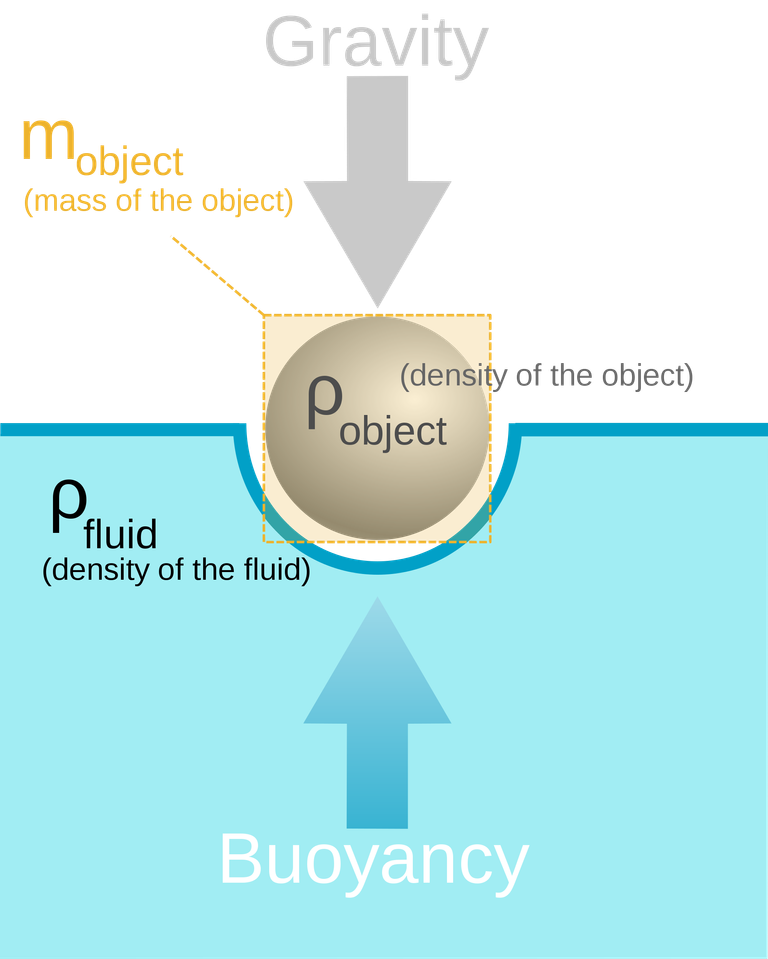This is part 1 of my basic physics series. In this series I will cover some fundamental topics in physics.
Buoyancy is the tenancy of an object to float in a fluid. To better understand this we must first understand what a fluid and a gas are, what their similarities are and what their differences are. A gas is a substance that can expand freely to fill any available space and not being limited by the quantity of the substance. A liquid is any substance that has the consistency of water or oil. it can flow freely but has a constancy volume. Both a gas and a liquid are fluids. A fluid is any substance that has no fixed shape and moves easily to external pressure

Density
Density is a measure of the mass over volume. This is shown by the ρ (rho). The volume is measured in meters cubed (m³)and the mass in kilograms. So if you had a 8,000 Kg block of metal measuring 1m by 1m by 1m, the density would be 8,000 kg/m³. It is good to note that some fluids are nearly in-compressible. One of them being water, which holds a steady density of 1000 kg/m³. Water does however compress slightly like all things though, just not substantially. If you were to go to the bottom of the ocean, the water there would have a bit higher density than the water at the surface of the ocean.

Buoyant force
The buoyant force, is the force felt on an object due to the water displaced by its volume. The buoyant force, represented by Fb.
When thinking about buoyancy, you need to think about two different scenarios, is the object floating on the surface of the fluid, or is it submerged in the fluid.
Weight
To understand the weight of an object, you need to know two things. What is the mass of the object? and what is the gravitational acceleration at that moment. weight and force are the same thing, measured by the equation, F=M x a.
F = the force in newtons (N)
M = the mass of the object
a = the acceleration of the object.
When it comes to gravity you cannot tell the difference between accelerating and the force of gravity. Say you were in an earth like environment with a gravitational acceleration of 9.81 m/s^2, and in an elevator. Now have the elevator free fall to the ground with no other forces acting on it. Because you are accelerating downward at the same speed that gravity pulls you, you will not feel any forces on you and it will seem as if you are in zero gravity. Until you hit the ground of course.
Back to buoyancy
Now that you have a grasp of weight, we can delve into more details of buoyancy.
Fb = Fg(of fluid displaced) or Fb = mf g
Fb = force of buoyancy
mf = mass of displaced fluid
g = acceleration of gravity

This allows us to understand that for an object to float, the force of buoyancy must be equal and opposite to the weight of the object. If an object has a higher weight per volume than the fluid it is in, it will sink because the force of buoyancy is not great enough to support the object.
if Fg > Fb, the object will sink
if Fg ≤ Fb, the object will float or stay where it was placed.

This is largely due to density. If an object has a higher density than water it sink in water because the volume that it takes up weights more than the volume of the fluid displaced. If the density is lower it will float because the volume it takes up weighs less than the same volume of fluid it is in. Through this we are able to find the force of buoyancy for a submerged object of a given density.
Suppose you have a 1m³ that has a density of 500 kg/m³, and submerge it in water which has a density of 1000 kg/m³. What would be the force of buoyancy that the object experiences?
1000kg/m³ x 1 m³ = 1000kg 500 kg/m³ x 1m³ = 500kg
1000kg x 9.81 m/s^2 = 9810 N 500kg x 9.81 m/s^2 = 4905 N
9810 N - 4905 N = 4905 N
The buoyant force of the submerged object is 4905 newtons.
Sources:
scienceprimer.com/buoyancy
upload.wikimedia.org/wikipedia/commons/thumb/7/7c/Buoyancy_corr.svg/2000px-Buoyancy_corr.svg.png
upload.wikimedia.org/wikipedia/commons/thumb/7/74/Buoyancy.svg/2000px-Buoyancy.svg.png
pixabay.com/static/uploads/photo/2015/11/25/20/38/scuba-diver-1062895_960_720.jpg
c8.staticflickr.com/3/2767/4223201023_1a8a6ab11b_b.jpg
upload.wikimedia.org/wikipedia/commons/thumb/7/71/Artsy_density_column.png/129px-Artsy_density_column.png
Hi,
I have a few comments about your post.
Thanks for considering my comments that could possibly improve your post. If you have any question, do not hesitate to come back to me.
Nice work. And probably the best username you could have for an article about buoyancy!
Thanks
Good article. As a scuba diver, it is curious to me how some people are really boyant while others sink! In scuba diving, you learn to adjust your buoyancy with your breathing and how much air is in your BCD and/or in your lungs.
What is the science behind this or is it just complex?
Just a guess, but I'd wager is has something to do with changing your volume while maintaining the same mass. Which would change your density and therefore buoyancy.
...or not?
I think so. I would also bet there is something too in the chemistry/makeup of the cells?
also, body fat percentage, bone density, muscle mass, et cetera.
True - all of that would weight in.
i love bath tub physics. thank you.
no problem. Glad you enjoyed the read :)